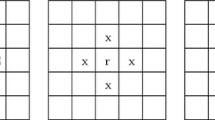Abstract
We study cellular automata where the state at each site is decided by a majority vote of the sites in its neighborhood. These are equivalent, for a restricted set of initial conditions, to nonzero probability transitions in single spin-flip dynamics of the Ising model at zero temperature. We show that in three or more dimensions these systems can simulate Boolean circuits of AND and OR gates, and are therefore P-complete. That is, predicting their state t time-steps in the future is at least as hard as any other problem that takes polynomial time on a serial computer. Therefore, unless a widely believed conjecture in computer science is false, it is impossible even with parallel computation to predict majority-vote cellular automata, or zero-temperature single spin-flip Ising dynamics, qualitatively faster than by explicit simulation.
Similar content being viewed by others
REFERENCES
A. L. Delcher and S. Rao Kosaraju, “An NC algorithm for evaluating monotone planar circuits,” SIAM J. Comput. 24(2):369–375 (1995).
L. M. Goldschlager, “A space efficient algorithm for the monotone planar circuit value problem,” Info. Proc. Lett. 10(1):25–27 (1980).
R. Greenlaw, H. J. Hoover, and W. L. Ruzzo, Limits to Parallel Computation: P-Completeness Theory, Oxford University Press, 1995.
K. Lindgren and M. G. Nordahl, “Universal Computation in Simple One-Dimensional Cellular Automata,” Complex Systems 4:299–318 (1990).
J. Machta and R. Greenlaw, “The computational complexity of generating random fractals,” J. Stat. Phys. 82:1299 (1996).
C. Moore, “Quasi-linear cellular automata,” Santa Fe Institute Working Paper 95-09-078, to appear in Physica D, Proceedings of the International Workshop on Lattice Dynamics.
C. Moore, “Non-Abelian cellular automata,” Santa Fe Institute Working Paper 95-09-081, or “Predicting non-linear cellular automata quickly by decomposing them into linear ones,” submitted to Physica D.
K. Moriarty and J. Machta, “Optimized parallel algorithm and dynamic exponent for diffusion-limited aggregation,” submitted to Phys. Rev. E.
C. H. Papadimitriou, Computational Complexity, Addison-Wesley, 1994.
Author information
Authors and Affiliations
Rights and permissions
About this article
Cite this article
Moore, C. Majority-Vote Cellular Automata, Ising Dynamics, and P-Completeness. Journal of Statistical Physics 88, 795–805 (1997). https://doi.org/10.1023/B:JOSS.0000015172.31951.7b
Issue Date:
DOI: https://doi.org/10.1023/B:JOSS.0000015172.31951.7b




